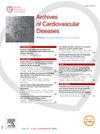Using novel machine learning tools to predict optimal discharge following transcatheter aortic valve replacement
IF 2.2
3区 医学
Q2 CARDIAC & CARDIOVASCULAR SYSTEMS
引用次数: 0
Abstract
Background
Although transcatheter aortic valve replacement has emerged as an alternative to surgical aortic valve replacement, it requires extensive healthcare resources, and optimal length of hospital stay has become increasingly important. This study was conducted to assess the potential of novel machine learning models (artificial neural network and eXtreme Gradient Boost) in predicting optimal hospital discharge following transcatheter aortic valve replacement.
Aim
To determine whether artificial neural network and eXtreme Gradient Boost models can be used to accurately predict optimal discharge following transcatheter aortic valve replacement.
Methods
Data were collected from the 2016–2018 National Inpatient Sample database using International Classification of Diseases, Tenth Revision codes. Patients were divided into two cohorts based on length of hospital stay: optimal discharge (length of hospital stay 0–3 days); and late discharge (length of hospital stay 4–9 days). χ2 and t tests were performed to compare patient characteristics with optimal discharge and prolonged discharge. Logistic regression, artificial neural network and eXtreme Gradient Boost models were used to predict optimal discharge. Model performance was determined using area under the curve and F1 score. An area under the curve ≥ 0.80 and an F1 score ≥ 0.70 were considered strong predictive accuracy.
Results
Twenty-five thousand and eight hundred and seventy-four patients who underwent transcatheter aortic valve replacement were analysed. Predictability of optimal discharge was similar amongst the models (area under the curve 0.80 in all models). In all models, patient disposition and elective procedure were the most important predictive factors. Coagulation disorder was the strongest co-morbidity predictor of whether a patient had an optimal discharge.
Conclusions
Artificial neural network and eXtreme Gradient Boost models had satisfactory performances, demonstrating similar accuracy to binary logistic regression in predicting optimal discharge following transcatheter aortic valve replacement. Further validation and refinement of these models may lead to broader clinical adoption.

使用新型机器学习工具预测经导管主动脉瓣置换术后的最佳出院时间。
背景:虽然经导管主动脉瓣置换术已成为手术主动脉瓣置换术的替代方法,但它需要大量的医疗资源,最佳住院时间变得越来越重要。本研究旨在评估新型机器学习模型(人工神经网络和 eXtreme Gradient Boost)在预测经导管主动脉瓣置换术后最佳出院时间方面的潜力。目的:确定人工神经网络和 eXtreme Gradient Boost 模型是否可用于准确预测经导管主动脉瓣置换术后的最佳出院时间:数据来自2016-2018年全国住院患者抽样数据库,使用国际疾病分类第十版代码。根据住院时间将患者分为两组:最佳出院期(住院时间为 0-3 天)和延迟出院期(住院时间为 4-9 天)。对最佳出院和延期出院患者的特征进行了χ2 和 t 检验。采用逻辑回归、人工神经网络和 eXtreme Gradient Boost 模型预测最佳出院时间。使用曲线下面积和 F1 分数确定模型性能。曲线下面积≥0.80和F1得分≥0.70被认为具有很高的预测准确性:对 2.5874 万名接受经导管主动脉瓣置换术的患者进行了分析。各模型对最佳出院的预测能力相似(所有模型的曲线下面积均为 0.80)。在所有模型中,患者处置和择期手术是最重要的预测因素。凝血障碍是预测患者是否最佳出院的最强共病因素:人工神经网络和极梯度提升模型的表现令人满意,在预测经导管主动脉瓣置换术后最佳出院时间方面,其准确性与二元逻辑回归相似。对这些模型的进一步验证和改进可能会使其在临床上得到更广泛的应用。
本文章由计算机程序翻译,如有差异,请以英文原文为准。
求助全文
约1分钟内获得全文
求助全文
来源期刊

Archives of Cardiovascular Diseases
医学-心血管系统
CiteScore
4.40
自引率
6.70%
发文量
87
审稿时长
34 days
期刊介绍:
The Journal publishes original peer-reviewed clinical and research articles, epidemiological studies, new methodological clinical approaches, review articles and editorials. Topics covered include coronary artery and valve diseases, interventional and pediatric cardiology, cardiovascular surgery, cardiomyopathy and heart failure, arrhythmias and stimulation, cardiovascular imaging, vascular medicine and hypertension, epidemiology and risk factors, and large multicenter studies. Archives of Cardiovascular Diseases also publishes abstracts of papers presented at the annual sessions of the Journées Européennes de la Société Française de Cardiologie and the guidelines edited by the French Society of Cardiology.
 求助内容:
求助内容: 应助结果提醒方式:
应助结果提醒方式:


